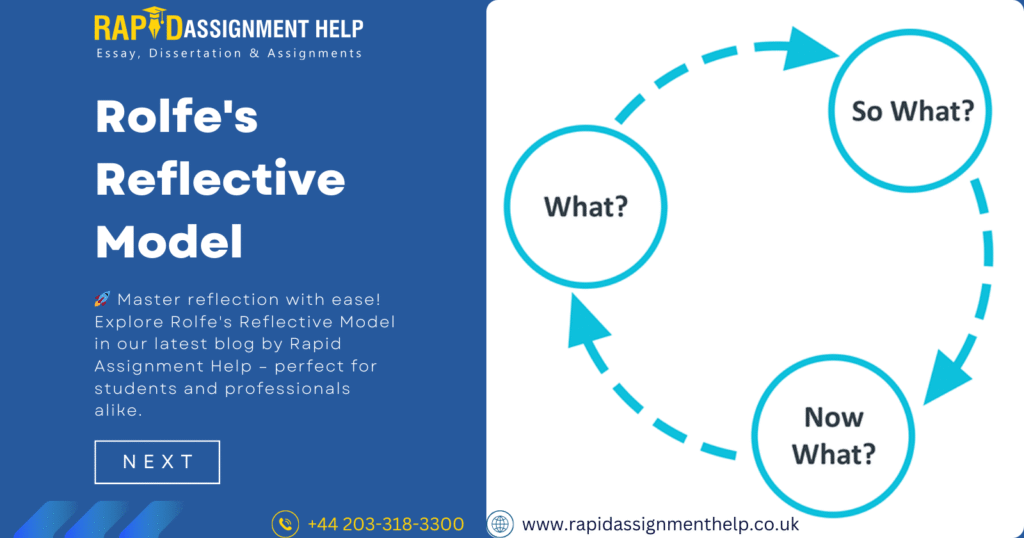Introduction
When thoughts feel scattered, Rolfe’s Reflective Model provides structure to understand and grow from what we go through.
This model, though rooted in professional development contexts, offers something far greater than a checklist. It acts as an inner guide—a reliable mental tool that helps you slow down, reflect with purpose, and make decisions that align with your goals and values.
What Is Rolfe’s Model?
Developed by Gary Rolfe and colleagues in the early 2000s, the model emerged from the field of nursing and professional education. However, its application has expanded far beyond healthcare. Today, Rolfe’s Model is used across education, business, social work, and personal development spheres.
The beauty of the model lies in its simplicity. It revolves around three core questions:
-
What? – What happened?
-
So What? – Why does it matter?
-
Now What? – What will you do next?
At first glance, these questions may seem basic. But in reality, they represent a structured process of experiential learning. You observe, analyze, and then act—all while building emotional intelligence and self-awareness.
This reflective loop not only helps in personal and professional growth but also cultivates a mindset of lifelong learning. The real magic is how it transforms experiences into insights, and insights into actions.
Why Clear Thinking Matters More Than Ever
Before diving deeper into how to use the model, it’s important to understand why clarity is so rare—and so valuable.
We’re constantly bombarded by input: emails, news, conversations, deadlines, social media feeds. Our minds are rarely still. This constant cognitive clutter clouds our ability to make thoughtful, reflective decisions. We become reactive rather than intentional.
Clear thinking doesn’t just mean intelligence—it means mental clarity, emotional regulation, and purposeful action. It’s the foundation of good leadership, effective teamwork, meaningful learning, and balanced living.
How to Use Rolfe’s Model Step-by-Step
Let’s break the model down in practical terms. Whether you’re reflecting after a difficult conversation, a team project, a class presentation, or a personal failure, the same steps apply.
1. What? – Observing the Experience
Start by describing the event or situation. Don’t interpret or judge—just write what happened.
Ask yourself:
-
What occurred?
-
Who was involved?
-
Where and when did it happen?
2. So What? – Analyzing the Meaning
Now comes the real reflection. Why does this experience matter?
This stage pushes you to explore:
-
How did the event make me feel?
-
Why did it affect me this way?
-
What does it reveal about my values, assumptions, or behavior?
3. Now What? – Planning for the Future
Reflection without action is just daydreaming. The “Now What?” phase is where you close the loop by applying the lesson.
Ask yourself:
-
What could I do differently in a similar situation?
-
What support or resources do I need?
-
How will I measure growth or improvement?
Using the Model in Real Life
You don’t have to reserve Rolfe’s Model for formal evaluations or assignments. It’s most effective when used frequently and informally. Here’s how:
Journaling
Keep a reflective journal where you regularly apply the What–So What–Now What structure. Over time, you’ll notice patterns in your behavior and thinking.
Professional Development
After meetings, client interactions, or projects, pause and reflect using the model. It enhances workplace communication, problem-solving, and emotional regulation.
Academic Growth
Use the model after lectures, feedback, or group work. It can help in understanding course content more deeply and developing critical thinking.
Personal Insight
Apply the model to emotional or interpersonal experiences—conflicts, choices, or changes. It builds self-trust and emotional clarity.
Why Rolfe’s Model Feels Like a Mental GPS
Just like a GPS recalculates your route when you take a wrong turn, Rolfe’s Model helps you mentally re-route after confusion, mistakes, or challenges. It doesn’t just show you where you’ve been—it helps you decide where to go next and how to get there with clarity.
Over time, you may find that you internalize the questions:
-
What just happened?
-
Why does it matter?
-
What should I do now?
When these questions become second nature, you’re not just reflecting—you’re evolving.
Conclusion
In the race of daily life, we often move from one task to the next without pausing to ask if we’re heading in the right direction. Rolfe’s Model offers a moment of pause—a mental checkpoint that helps you course-correct before burnout, poor decisions, or missed opportunities pile up
So next time you feel stuck, overwhelmed, or unsure—don’t just react. Reflect. Let Rolfe’s Model guide you from confusion to clarity, from noise to insight, from reaction to thoughtful action.













































